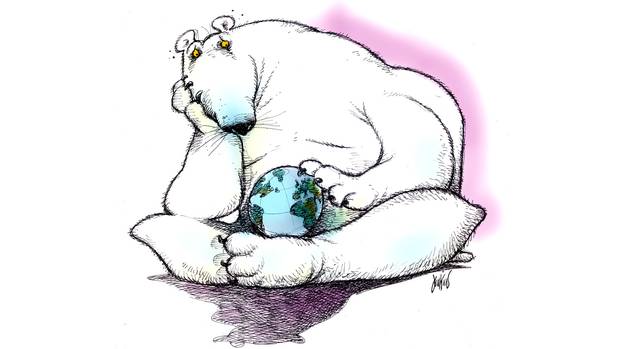Ice, Please – Climate on the Rocks
Globe and Mail
Any day now, the expanse of sea ice in the Arctic will reach its lowest extent for the year. The round-the-clock summer days have gone, and the weather is turning sharply colder as the sun sinks below the horizon for longer periods each day. These temperatures halt the melting process that began in March. Slowly, new ice will start to form across the Arctic Basin.
This year’s sea-ice minimum will be the lowest since satellites began taking measurements in the late 1970s. For weeks, climate scientists around the world have been checking the daily Arctic ice reports from the National Snow and Ice Data Center in Boulder, Colo. Since mid-July, the extent of sea ice has tracked almost continuously below the record lows of 2007. At 3.5 million square kilometres, the 2012 minimum will beat 2007 by half a million square kilometres – an area the size of Yukon – and be nearly 50 per cent below the 1979-2000 average.
This is an astonishing change. But is it really new? The question has moved to the centre of the polarized debate over whether climate change is happening, if so what’s causing it, and whether it matters.
Those who deny the reality or significance of climate change often say Arctic sea ice also shrank dramatically as recently as the 1930s, so what’s happening now is just part of a natural long-term fluctuation. But the best recent analysis, published in the top scientific journal Nature last November, says that “both the duration and magnitude of the current decline in sea ice seem to be unprecedented for the past 1,450 years” and that the recent decline is “consistent with [human-caused] warming.”
Indeed, climate scientists increasingly believe we’re seeing a rapid and irreversible shift in a major feature of Earth’s climate system.
So what? some say – the Arctic is a distant corner of the planet and relatively few people live there. Sure, climate change may hurt indigenous people who depend on the ice for their livelihoods, but look at the advantages for everyone else: far shorter shipping routes across the Arctic Ocean and access to supposedly vast reserves of oil and gas under the newly opened sea.
If only things were so simple. A rapidly emerging line of climate research indicates that what’s happening in the Arctic boosts the likelihood of extreme weather – heat waves, flooding, severe drought, and even prolonged snowfall and cold spells – across the Northern Hemisphere’s mid-latitudes.
This research is at the frontier of climate science, so a great deal remains unknown. But the basic logic works like this: As more ice melts from the Arctic each spring and summer, the dark ocean revealed absorbs more solar energy. This heat is released back into the atmosphere in the fall and winter, increasing the air temperature over the Arctic, which, in turn, reduces the temperature difference between air in the Arctic and air farther south.
This temperature difference is what drives the high-altitude wind called the jet stream that circles around the Arctic from west to east and forms a partial barrier between the atmosphere in the Arctic and elsewhere. But as the temperature difference between air to the north and south of this barrier has declined, the speed of the west-east flow appears to have declined, too, by about 20 per cent in the past few decades.
Also, as the temperature difference has declined, the jet stream’s north-south meanders appear to have become more pronounced. According to Rutgers University’s Jennifer Francis, one of the scientists leading this research, these north-south loops in the jet stream, called Rossby waves, have become more elongated northward. More important, the normal west-east movement of these waves around the planet has slowed.
On the ground, the result is more persistent weather. Slower moving waves in the jet stream – whether they drag cold air from the north or warm air from the south, or bring heavy rain or clear skies – mean your weather will stick around longer.
This new research tells us the Arctic isn’t a side show. The effects of climate change there are likely making weather more extreme across much of the Northern Hemisphere. And it indicates we can’t assume any more that we can punt the climate-change problem into the future. In very real ways, it’s affecting all of us now. So the time to respond is now.

Topics
Climate Change
Energy
Environmental Stress and Conflict
